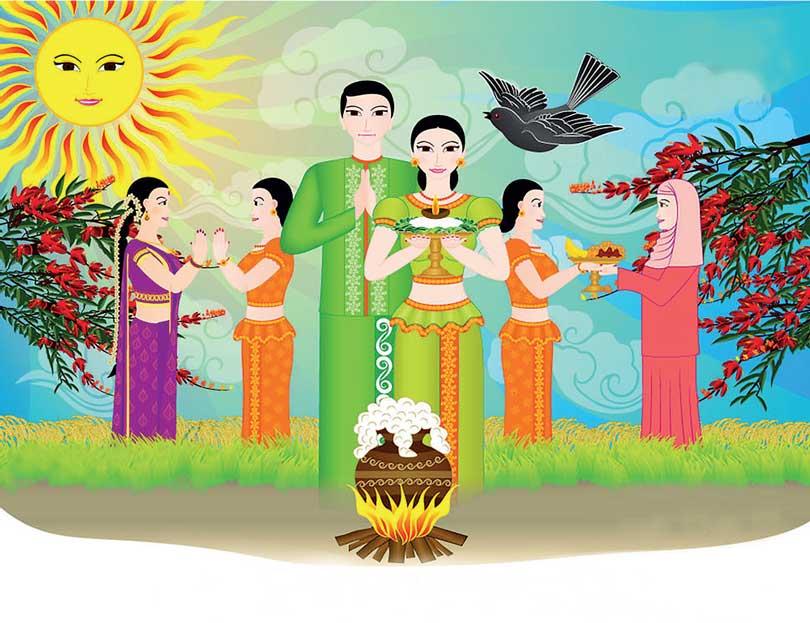13 Apr 2021 - {{hitsCtrl.values.hits}}

 A year is a period of 12 months or 365 days or 366 days in case of leap year. People celebrate the last day of the year ending and the first day of the year dawning. In Sinhalese we call them the “Parana Avurudda” and “Aluth Avurudda respectively. In other words they are the old year day and the New Year day respectively. For Sinhala and Tamil communities the festive season falls usually on April 13 and 14. Plaintive cuckoo sings and Sakura (Cherry) blossom in Japan and coral trees in our country blossom to tell us that our national and cultural festive season is approaching.
A year is a period of 12 months or 365 days or 366 days in case of leap year. People celebrate the last day of the year ending and the first day of the year dawning. In Sinhalese we call them the “Parana Avurudda” and “Aluth Avurudda respectively. In other words they are the old year day and the New Year day respectively. For Sinhala and Tamil communities the festive season falls usually on April 13 and 14. Plaintive cuckoo sings and Sakura (Cherry) blossom in Japan and coral trees in our country blossom to tell us that our national and cultural festive season is approaching.
Calculation of auspicious hours
Astrologically this is the transition of the sun from the House of Meena (Pisces) to the House of Mesha (Aries) which is regarded as the dawn of the New Year. For us in Sri Lanka this is the most important national and cultural festival. We make this an occasion to observe religious rites and rituals and also to engage in cultural traditions and observations.
A few minutes before the end of the old year we go to the temple and observe religious rites and immediately after the dawn of the New Year we repeat the religious observations. Those who are unable to go to the temple observe the religious rites at home during the “Nonagatha” period and continue after the dawn of the New Year. These religious observations are called “Devurudu Wandana” meaning worshiping during both years.
Nonagatha Kalaya - Period does not belong to any Lunar mansion
There is an interim period between the old year and the New Year. This is called the “Nonagatha Kalaya” which is regarded as an unlucky or inauspicious period of time not belonging to any lunar mansion. Hence this period is not suitable for any act and is devoted exclusively for religious observations.
Customs and observations
Apart from Devurudu Wandana there are various other customs and observations relating to the New Year day and afterwards. There are yet other customs and traditions which are observed in anticipation of the dawn of the New Year. The third category of functions relates to the Nonagatha or the inauspices period of time in between the old year and the New Year.
Astrologer’s sheet indicating auspicious moments
The earliest and the most important custom is the distribution of the astrologer’s sheet or chit in which auspicious moments for various observations are indicated. Today this information is disseminated through the media but in the past the service was rendered by the village astrologer called the “Ganithaya” or the calculator of horoscopes. Auspicious moments for the observation of various traditions and customs were made known to the ordinary villagers by the astrologer. Villagers depended on the Ganithaya for this service. Ganithaya was not paid for this service but paddy, coconuts etc. were given to him in exchange of the astrologer’s sheet. This chit indicated the auspicious time for the last anointment and bathing for the old year, lighting the fire and having the first meal for the New Year, the auspicious time for the sight of the new moon and the auspicious time to set out for work. Ten to twelve days before the auspicious day the villagers commence the work of cleaning the house and the environment. After cleaning the house and the environment villager’s start the preparation of sweetmeats for the New Year days following.
Sweetmeats for New Year day and after
Villagers prepare various kinds of oil cakes,”Kokis”, a pastry made of flour and “Aluwa”, a diamond-shaped sweet and many other eats. Usually the first item to prepare is “Asmi”, a confection, a sweetmeat made of flour, oil etc. They start preparing this item first because the preparation takes a long period of time having to fry on two occasions.
They take special care not to speak when oil is poured to the frying pan for preparing oil cakes and other sweetmeats. They believe that if oil is poured into the frying pan at the time when someone is talking the wastage will be more. The housewife or the mother who heads the kitchen department says “Hapura” as a means of warning the others to keep silence at the time of pouring oil into the frying pan.
Special preparations are made for the consumption when participating in New Year games. Towns and suburban areas getting reduced to deserted villages.
Since Avurudu is celebrated mainly in villages towns and suburban areas are like deserted villages on and around the New Year day because almost all the people go to their native places in villages although people throng the cities in the eve of the auspicious day for purchasing and marketing. In any event New Year rituals are performed by the town dwellers who remain in their abodes in the town.
Those who live away from their parents come to their ancestral homes to spend the New Year as members of extended families. It is customary for youngsters to offer handfuls of betel leaves to elders including parents and grandparents and bow down before them. Elders bless them for a prosperous New Year. Youngsters confess for pardon if they had done anything to annoy their elders during the year ended. This is also a rare occasion to get the wounds of enmity healed.
Customs, traditions followed in Nonagatha
Nonagatha is an inauspicious period not belonging to either the old year or the New Year and not belonging to any lunar mansion people devote the entire period of Nonagatha for religious observations. Hence, Nonagatha is also called the “Punya Kalaya” meaning the time period meant for religious observations. Water, fire and milk which are regarded as symbols of prosperity are taken into the house before the commencement of the Nonagatha period.
Preparation of first New year meal
The most important event of the New Year is the preparation of the first meal of the year. Exactly at the auspicious moment inmates led by the mother or the grandmother in the case of extended families prepare the hearth or the fire place and light also at the auspicious moment. The first pot to be placed on the hearth is a pot of milk rice because water, fire and milk are regarded as symbols of prosperity. Rice milled from the new harvest is used for the preparation of milk rice. Inmates consume the first meal together with the blessings of parents and grandparents and love and affection from the young ones.
Ganudenu - Transactions by well wisher
The meal is usually followed by transactions – Ganudenu. The first transaction of the year is usually begins with the blessing of the well by the villagers and well wishers. The mother or an elderly female member of the family goes to the well with a pot and a pack containing a coin representing monetary offerings, some milk rice, saffron and chillies. The pack is dropped into the well before collecting water. Transaction with the well or the water place is followed by the transaction proper. Villagers go to a special person and greet him or her after offering betel and a small sum of money as a token. The well wisher adds something more and returns it. They think and hope that the whole year would be prosperous with the blessings of the well and the well wisher.
Start work in New Year
There is another auspicious time for starting work in his or her respective job or in the place of work. At the auspicious time indicated by the astrologer or made known through the media they set out to their respective places of work to commence the work in the respective job. The village temple had been and continues to be the centre for performing the New Year rituals. The priest of the village temple, school principal, ayurvedic physician, vel vidhane and the village headman who are honoured as village leaders. Today there are various politically appointed village leaders or represented by various societies and organizations to provide leadership to the villagers. Get to-gethers known as Bak Maha Ulelas are organized with the guidance and assistance provided by these leaders for the villagers to enjoy the New Year.
Nanu snanaya - Oil anointing ceremony
An ointment called Nanu is prepared in the village temple or in the ayurvedic physician’s house is an ointment for anointing the heads and a composition to cleanse the hair. Various kinds of herbs including lime and gingeli oil are used to prepare this ointment. In Sabaragamuwa area, the main anointment ceremony is conducted at the Maha Saman Devalaya Immediately before starting the anointment ceremony a drum roar is performed. The drum roar is heard by the people in the area. This is called the “Nanu Hevisiya.
Protection of ointment prepared for anointing
The ointment for anointing the heads of villagers at the auspicious time is also prepared and protected while chanting “Seth Pirith.” This ointment which is supposed to have favourable effect on the health of the people is distributed among the villagers for anointment at the auspicious time recommended by the astrologer.
27 Nov 2024 5 minute ago
27 Nov 2024 46 minute ago
27 Nov 2024 2 hours ago
26 Nov 2024 26 Nov 2024
26 Nov 2024 26 Nov 2024